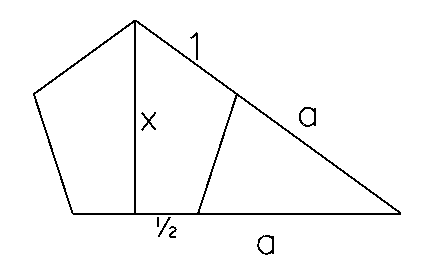

Let x be the height of the pentagon and r be the distance from the center to any corner. The height of the pentagon was solved in problem 47 as (2*51/2+5)1/2/2. The area of the pentagon equals 10 times the area of the triangle shown in the following diagram.

We already know r so let's solve for x in terms of r using the pythagorean formula on the triangle in the diagram above.
(1/2)2 + (x-r)2 = r2
1/4 + x2 -2xr + r2 = r2
1/4 + x2 -2xr = 0
r = 1/(8x) + x/2
So x-r = x/2 - 1/(8x)
The area of each triangle is 1/2*base*height = x/8 - 1/(32x)
The area of the pentagon is 10 of these triangles = 10x/8 - 10/(32x) = 5x/4 - 5/(16x) = (4x2 - 1)/(32x).
We know from problem 47 that x = (2*51/2+5)1/2/2. Substituting this value for x in the above equation results in an area of (25+10*51/2)1/2/4 =~ 1.7205.
The next step is hard to explain without a picture, however I will try. Consider three consecutive corners of the pentagon and label them a, b, and c. Next draw a line from a to c. Call d the point in the middle of segment ac. Now consider the triangle abd. This triangle has angles 36, 54, and 90. We also know the hypotenuse is 1 and longer base is half the distance between any two non-adjacent corners, or (1+sqr(5))/4. From this we can deduce that cos(36)=(1+sqr(5))/4.
Next extend a segment from all five corners of the pentagon and all five midpoints of each side. This will divide the pentagon into 10 equal triangles. Each of these triangles conveniently also has angles of 36, 54, and 90. Next lets define the following:
r=distance from any corner of pentagon to center of pentagon
y=distance from the midpoint of any side to the center of pentagon
r+y is the height of the pentagon, which from problem 47 is sqr(5+2*sqr(5))/2.
The ratio y/r = cos(36) = (1+sqr(5))/4.
Now we have two equations and two unknowns. At this point we grind out the algebra to find that:
r=2*sqr(5+2*sqr(5))/(5+sqr(5))=~0.850651
y=sqr(25+10*sqr(5))/10=~0.688191
The pentagon is composed of 10 right triangles, each of area 1/2*1/2*y. The area of the pentagon is thus (10/4)*y = sqr(25+10*sqr(5))/4 =~ 1.720477.
Thanks to Mark Hoyle for some help with this problem.
Michael Shackleford, A.S.A., October 9, 2001